Don't wanna be here? Send us removal request.
Note
Is it true that Ling Tong was dead only a little while after Hefei? If so, I can’t help but feel a bit disappointed considering how often he is depicted in modern media as surviving well past that point.
Yes, died in 217. Having recovered from his major injuries, he welcomed a fellow county-man Sheng Xian (who someone had argued was superior) and then was sent for a camapign against rebels and locals in the east but died during a brief stop in his home area.
However the novel has him fighting at Yiling and the novel has a big influence on way people see the era.
17 notes
·
View notes
Text
Dynasty Warriors: Who Is Zhurong?
It’s somewhat amazing that anyone even talks about Zhurong. Although she almost certainly has her origin in earlier folktales and operas, she appears in only one chapter of the Romance of the Three Kingdoms but has overshadowed many other individuals who had much more time on the page. Maybe the idea of a tough Amazon is just too interesting for people to overlook.
Despite being a very minor figure in a much, much larger story, Zhurong has had a steady presence in Three Kingdoms adaptations for over 20 years now; at least as far as gaming goes. She made her introduction on the scene with Romance of the Three Kingdoms IV in 1994 and has appeared in most installments of the series ever since.
Years later, in 2001, Zhurong was introduced as a playable character in Dynasty Warriors 3. She was removed in DW6 but returned in DW7 and has remained a steady presence in the franchise and its spin offs ever since.
Zhurong is also one of the few characters who has had a more or less consistent personality throughout her history in the DW franchise. She’s a tough woman with a temper, one who doesn’t tolerate foolishness. She is also fiercely protective of her homeland and very affectionate to her husband, Meng Huo. She doesn’t make many appearances in those games but she’s usually part of the more unique stages inspired by Zhuge Liang’s southern campaign of 225.
She’s popped up in a few other places too. Zhurong has the distinction of being one of few characters featured as a monster card in an odd 1999 Magic the Gathering set. I haven’t played enough MTG to know if these stats are good, but the mere fact that she is present is kind of wild.

She appeared in the famously bizarre Kessen II (2001) and you can also find Zhurong in Total War: Three Kingdoms. Though not included in the game’s 2019 launch, she was one of the unique officers added with 2020’s The Furious Wild expansion.
I’m listing all these appearances because when you look at her origin, it’s nuts that she has this kind of consistent (if small) presence.
These different versions of Zhurong are all inspired by her appearance in Chapter 90 of the Romance of the Three Kingdoms. It’s difficult to stress how brief this appearance is. Not only is it limited to a single chapter, her part is so short that it all easily fits in this essay.[1] You can read along for yourself at https://www.threekingdoms.com/090.htm
Meng Huo was much distressed. Before he had recovered, they told him: “The army of Shu has come over and is encamped at the mouth of Silver Pit Ravine.” Just as he was in the very depths of distress, a laugh came from behind the screen.
A minor note, because this will come up later: Dynasty Warriors usually depicts Zhurong riding an elephant. As you can see, she rides a horse in the Romance story. That same chapter does have elephants, though, being used by the chiefs Mulu and Wutugu. For what that’s worth.
The novel’s version of Zhang Ni and Ma Zhong don’t get the clout their historical counterparts deserve, but Zhurong winning out against them though both strength and cleverness does make for an interesting character. In the context of the story, it has to be a compliment that Zhuge Liang decided it would take Zhao Yun, Wei Yan, and Ma Dai to bring her down.
The Historical Zhurong
It’s a pretty widely known fact at this point that Zhurong, as depicted in the Romance and its adaptations, is a fictional character. Nevertheless, stories generally come from somewhere, and we can point to at least one figure of the Three Kingdoms era who likely inspired part of the Zhurong tale.
Lady Trieu
In the year 248, local forces in Jiaozhi and Jiuzhen revolted against the state of Wu. Emperor Sun Quan appointed a man named Lu Yin (a relative of Lu Xun) as the head of the province and sent him to put down the revolt. Lu Yin did so with relative ease. After meeting up with friendly local forces, he marched to the troubled area, giving generous rewards along the day. This quickly satisfied enough of the locals that the rebellion fizzled out. Lu Yin remained in the south for the next 10 years, putting down at least one other significant revolt in Cangwu and Jianling.[2]
Vietnamese sources record that during this time, there was a rebel leader known as Lady Trieu (Triu Au). The more or less standard version of the story can be found in the Complete Annals of Great Viet, completed in 1479.[3] All accounts of Lady Trieu agree that she was a ferocious warrior who rode on an elephant. They also write that she had breasts that were so long she could throw them over her shoulders. I have no comments on that but it felt like something I should mention. She was worshiped by a local cult following her death in battle against the Wu forces.[4] A Vietnamese king, Ly Bi, dedicated a shrine to her in the 6th century.[5]
While there is certainly room to debate the specifics of these various accounts there is no particular reason to doubt that Lady Trieu was a real person, a warrior and rebel leader. The similarities between her and the character of Zhurong are broad but easy to spot. With Lady Trieu being a leader of indiginous rebels during the Three Kingdoms era, it’s fair to assume that the legend of Zhurong found some inspiration from her.
Lady Cuan
Other sources of inspiration for the Zhurong can actually be found closer to home. One of the most important families of the Nanzhong region was the Cuan family. A stele created in the 5th century and dedicated to Cuan Longyan states that the family was descended from the Chinese fire god Zhu Rong.[6] This is, of course, a claim made by the fictional woman and the source of her name.
The Cuan family was prominent in 225, when Zhuge Liang led his campaign against rebels in the south. Cuan Xi is described as an uncle to both Yong Kai and Li Hui; the former being the main leader of the rebellion and the later being the official Shu tasked with governing Nanzhong. Both of their mothers must have been of the Cuan clan. After the rebellion was subdued, the Shu government acknowledged Cuan Xi as a general with independent command and validated his family’s control over the territory around Lake Dian.[7]
In the Cuan we find a powerful family of Nanzhong who played an ambiguous role in Yong Kai’s rebellion. They were connected to other regional magnates through marriage and claimed descent from a fire deity. It may be that the Cuan have some foothold in the later legend of Zhurong.
It would be going too far to say that Zhurong was a historical person, but there is more truth to her story than one might expect. We can see the root of her legend in the Cuan family and in the story of Lady Trieu. That’s a firmer foundation than Zhou Cang, at any rate.
Though never one of the most popular figures of Three Kingdoms lore, Zhurong has still achieved an outsized presence compared to her very brief appearance in the Romance. I generally like these adaptations, but I would love to see them lean into her historical roots more, such as they are. Giving her the Cuan surname would be a very firm step in that direction, giving her one foot firmly planted in the real world. It would be a good way to represent one of Nanzhong’s local powers and it could be interesting to see her grapple with the Cuan clan’s conflicted loyalties.
Endnotes
1. SGYY 90 2. SGZ 61.3 (Yang) 3. Ngõ, S. L. (2020, September 18). Đại Việt Sử Ký Toàn Thư - Ngoại Kỷ Toàn Thư 4: Thuộc Tấn - Tống - Tề - Lương. Lý Nam Đế. Đại Việt Sử Ký Toàn Thư. Retrieved March 25, 2022, from https://www.diensu.com/2020/09/ai-viet-su-ky-toan-thu-ngoai-ky-toan_1.html 4. Taylor, K. W. (1983). The Birth of Vietnam. University of California Press. p.70 5. Taylor, K. W. (1983). The Birth of Vietnam. University of California Press. p. 110 6. Cuàn Lóngyán Bēi 爨龙颜碑 7. For more on this campaign, see https://classicalamateur.wordpress.com/2020/08/21/the-laixiang-expeditions/
27 notes
·
View notes
Note
How were you introduced to Dynasty Warriors?
Dynasty Warriors 3 was my first introduction to the series.
2 notes
·
View notes
Text
This is heart wrenching.
Nichelle Nichols (Lt. Uhura) has been suffering from Dementia for years. She’s lots most of her money, the home she loved and there is a fight for her conservatorship
Her sister has set up a GoFundMe site for her. The link is at the very bottom of this post. Please share this information.
Read the article below and please donate if you can. Even a couple dollars will help.
https://www.al.com/life/2021/08/nichelle-nichols-star-treks-lt-uhura-faces-heartbreaking-conservatorship-fight.html

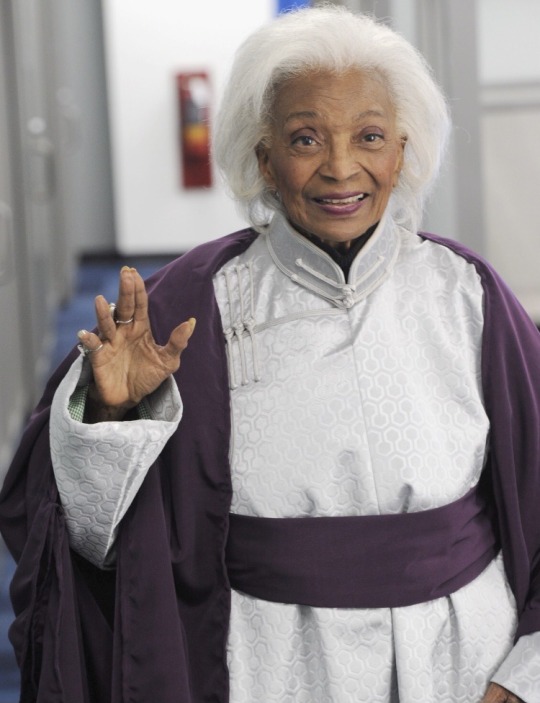
https://gofund.me/376980a8
71K notes
·
View notes
Text
The beginning of the Commentary on the Water Classic
The Shuijing水經 or Water Classic is a terse geographical work by Sang Qin who lived during Eastern Han or Three Kingdoms era.
The Shujingzhu水經注 or Commentary on the Water Classic by the Northern Wei official Li Daoyuan massively expands on the original text.
Jing經 when referring to a literary work is usually translated in English as Classic. In its more basic and literal meaning, 經 refers to thicker vertical threads (the warp) on a weave which the horizontal threads (the weft) are woven around. Conceptually then, a jing經 text creates the core framework that other texts can be written around.
In my translation below, the core Water Classic is in bold while the Commentary is in normal font. I have grouped the Commentary sections somewhat more together to allow the Classic be more easily read on its own.
he Kunlun Barrens崑崙墟 are in the north-west[1],the distance to the Song Heights嵩高 is 50 000 li, it is the centre of the land[2]. Its height is 11 000 li[3].
(A distance of 50 000 li is about half the circumference of the Earth.)
[1]Three layers make up the Kunlun Hills崑崙丘.
The Explanation of Kunlun says: The mountain of Kunlun崑崙 have three steps. The lower is called Fantong樊桐, and is also named Bantong板桐. The second is called Xuanpu玄圃, and is also named Langfeng閬風. The upper is called Cengcheng層城, and is also named Tianting天庭[“Heaven's Courtyard”], here are the dwellings of the Grand Deity.
[2]The Basic Annals of Yu and this are similar. Gao You claim the He River河出 sets out from Kun Mountain崑山, it flows hidden within the earth for 13 000 li. Yu directed and then opened it, to set out from Jishi Mountain積石.
According to the Classic of Mountains and Seas, from Kunlun崑崙 until Jishi積石 is 1 740 li, and from Jishi積石, from it sets out from Longxi隴西 commandery to Luo洛, in the standard Geographic Treatises it can be more than 5 000 li.
Also, according to the Transmittals on the Majestic Son of Heaven, the Son of Heaven from Kun Mountain崑山 entered into Zongzhou宗周, and then numbered the li to the western lands. From Zongzhou宗周 river and westward, until the nation of Hezong河宗 and the mountain of Yangyu陽紆, there were 3 400 li. Westward from Yangyu陽紆 to the head of the He河, there were 4 000 li, for a combined 7 400 li.
The Map of the Outer States also states: From the state of Great Jin, heading straight west for 70 000 li, one get to the location of Kunlun崑崙, the various immortals dwell there.
The several explanations are not similar. The way is difficult and moreover long, and the classics and records are entangled and denuded. The water and land roads are unusual, and paths are again not similar. There are superficial looks and peripheral hearings, but nothing is thoroughly investigated. [We] are unable to not depend on describing what has been heard or seen, and so write down where they deviate and contradict.
[3]The Classic of Mountains and Seas claim it is 800 li square and 10 000 ren tall. Guo Jingchun [Guo Pu] considered them to be more than 2 500 li from the top. The Master of Huainan claims it is 11 000 li, 114 bu, 3 chi, 6 cuntall.
The He River河水[4]sets out from their north-eastern corner[5], bending to follow its south-eastern flow to enter into the Bo Sea渤海.
[4]The Spring and Autumn's Explanations of Topics and Phrases says: A word for the He河 is lotus [he荷]. The lotus' essence is divided and spread out, holding dear the shadowy and bringing forth measurement.
The Interpreting Names says: He 河 means “lower”. It follows the earth to a lower place and then flows through.
The Examinations into the Different and Unusual says: The He河 is the breath of water and the essence of the Four Conduits, by which they flow and transform.
The Wrap of Primal Instructions says: The Five Agents begin with it. It is what causes life for the ten thousand beings, and the wrinkles and sap of the primal breath.
Master Guan says: Water is the blood and breath of the earth, flowing through it like muscles and blood vessels, for that reason it is said that water provides wealth. Among the Five Injuries, floods are the greatest. Rivers are great and small, and are distant and near. Those rivers that set out from the mountains and then flows to enter the sea, the instructions call Main Rivers. Those that bring forth other rivers to enter into a great river and the sea, the instructions call Branch Rivers. Those that set out into earthen drains, and flows into great rivers, and into the sea, again the instructions call Stream Rivers.
Master Zhuang says: When the time of autumn floods arrive, the hundred streams pour into the He河, to the greatness of the main flow.
The Classic of Filial Piety's Guide to Godly Pacts says: The He河 is the elder among rivers, its correspondence above is the Heavenly Han (the Milky Way).
The New Discussions says: Of the sources of the Four Conduits, the He河 is the highest and the longest. Pouring down from the heights, the water flow hurtles steeply, and for that reason its flow is quick.
Xu Gan's Rhapsody on Qi Commandery says: Of streams and conduits, then the Vast He is immense and unending, springing forth from Kunlun. Nine flows split off and go away, [into the] northern morning's deep green abyss. Startling waves are sudden and sharp, the floating foam scatters and flees.
The Comprehension of Manners and Customs says: The Jiang江, He河, Huai淮, and Ji濟 are the Four Conduits. A conduit is something that passes through, from that they pass through the Central States' dirt and mud.
The White Tiger Comprehensions says: Their potency is visible and great, and for that reason they are addressed as Conduits.
The Interpreting Names says: A conduit is something which is alone, each are alone from where they set out and then enter the sea.
[5]The Classic of Mountains and Seas says: The Kunlun Barrens崑崙墟 are in the north-west. The He River河水 sets out from its north-eastern crook.
The Erya says: When the He河 sets out from the Kunlun Barrens崑崙墟, it is coloured white. Where channels combine one thousand seven hundred and one streams, it is coloured yellow.
The Discussion on the Order of Things says: The He河 being coloured yellow: The flow of multitude streams perhaps muddies it. For [every] hundred li there is one small bend, for [every] thousand li it has one bent and one straight [part].
Han's Grand Marshal Zhang Zhongyi says: The He's河 water and mud clears and settles into one shi of water, six dou of mud. But the people vie to draw out the He to irrigate the fields, and causes the He河 to not pass through gainfully. Arriving at the 3rd Month, when the peach-flower water arrives,. then the He河 bursts forth due to its blockage not spilling. Forbid the people so they do not again draw out the He河, this is the name of the Yellow He黃河 and also the Muddy He濁河.
The Records of Narrated Travels says: Meng Ford 盟津 and He Ford河津 are constantly muddy. Side-by-side the Jiang江 it is narrow, in comparison to the Huai淮 and Ji濟 it is broad. When cold, the ice is several zhang thick. When the ice begins to gather, chariots and horses do not dare to go over. They demand a fox travel, stating this creature has good hearing, and if below the ice there is no water, then it goes over. When people see a fox travel, they soon after cross over.
I lean on the Comprehension of Manners and Customs which states: A saying in the hamlet[s?] delcares that "when a fox wishes to cross over the He河, there is nothing to be done about the tail." This fox is by nature very distrustful, and for that reason customs have explanations of the fox's distrust. Likewise it is not necessay that [this] one is like the words of Yuansheng.
(Guo Yuansheng was the author of the Record of Narrated Travels.)
23 notes
·
View notes
Text
Zuo Ci, from Alchemists, Mediums, and Magicians: Stories of Taoist Mystics
Alchemists, Mediums, and Magicians: Stories of Taoist Mystics is a collection of biographies of 144 historical figures associated with Daoism, compiled under the title Xuanping lu 玄品錄 by daoist Zhang Tianyu 張天雨 (1279-1350) and translated by Thomas Cleary.
Zuo Ci was styled Yuanfang. He was a man of Lujiang.(8) In youth he learned the Five Classics and mastered astrology as well. Seeing the fortune of the Han dynasty about to end, with disorder arising throughout the land, he lamented, “In this time of decline, those in high offices are in danger, while those with a lot of property will die. Glory in the present age is not worth hankering after.”
So he studied Taoist arts and meditated on Pillar of Heaven Mountain.(9) Finding an alchemical scripture in a cave, he put it into practice and could transform in myriad ways.
Cao Cao summoned him to test him, wishing to learn the Way from him. Ci said, “To learn the Way requires purity, without contrivance; it is not suitable for those in high positions.” Cao was envious by nature and repeatedly tried to kill him but was unable to do so.
When Ci was in Xing province, Liu Biao was governor; he too wanted to kill Ci, thinking him to be confusing the populace. Knowing of this beforehand, Ci went away from Biao, going east. Then when he met Sun Quan, the ruler of Wu, Quan already knew Ci had the Way, so he respected him courteously.
According to Declarations of the Realized, “Ci is now on Little Gua Mountain; always coming and going, he has repeatedly been down here seeking to take on more work. Ci’s face appeared very young; he had indeed attained the benefits of the nine products of furnace and fire. He lives in seclusion in the Guacang Mountains.(10) Toward the end of the Jian-an era [196–220], Ci once crossed the river to visit Maoshan and got access to the caves. He also begged for cinnabar to compound nine-product elixir. He was a teacher of Li Zhongfu’s disciple Ge Xuan.”
Footnotes:
Keep reading
27 notes
·
View notes
Text
An examination of Cao Cao’s “I would rather betray the world than let the world betray me”
This is a famous quote popularized by Romance of The Three Kingdoms, and many people came to know Cao Cao because of this quote, along with some of his atrocious deeds, like his killing of Lü Boshe (Hereafter LBS) which ultimately lead to the aforementioned quote. (In the Romance)
Did Cao Cao really say this after killing LBS?
If we are talking about the exact wordings, the answer is a definite no. However, if we are talking about something along that line, then Cao Cao supposedly did say it. I used ‘supposedly’ here because things can get more complicated. I will attempt to touch on that later.
The quote, in Chinese “寧教我負天下人,休教天下人負我”, is only found in the novel. A quote of a similar fashion, “寧我負人,毋人負我!” is, however, found in Records of The Three Kingdoms (三國志, hereafter SGZ).
To understand this quote, and to translate it properly, we would need to look at the whole paragraph.
太祖聞其食器聲,以為圖己,遂夜殺之。旣而悽愴曰:「寧我負人,毋人負我!」遂行。
Cao Cao heard the sounds produced by LBS’s utensils, and thought that LBS was planning to kill him, hence Cao Cao killed him at night. He then said sorrowfully, “ I would rather betray others, then let others betray me!”, and left.
Logically, it doesn’t make sense that someone in great sorrow right now would say something about betraying others. Or is it?
In my opinion, I believe this is Cao Cao’s way of reconciling with his own conscience, to come to terms with what he has done. As we can see from the original quote, he was in great sorrow over the killing of LBS — perhaps he didn’t want to kill LBS, or that he realized there wasn’t a need to afterwards.
Regardless of what happened during and before the killing, Cao Cao was definitely regretful after the killing, and stating this quote would make sense as a sort of self-comfort to convince himself that what he did was for the best and in alignment with his beliefs. And with that, then can he continue his travels and future conquests with , hopefully, lesser guilt and regrets.
It’s not something very noble, but it’s not something very despicable as well. It was perhaps merely a defense mechanism to cope with a traumatic incident. The romance simply took it with extra force and expanded the whole scope to the ‘world’, in order to fit its own storyline ideologies.
Issues with history records
In the original SGZ by Western Jin Historian Chen Shou (陳壽), there were no mentions of LBS, or the incident of Cao Cao killing somebody in that fashion.
What I quoted earlier on was the annotations of SGZ by a later Historian Pei Songzhi (裴鬆之). Where did PSZ get his annotations from? He consulted other non-official records, and wrote their versions of this story down as reference. In fact, he found 3 versions of this story, and I will quote them below:
魏書曰:太祖以卓終必覆敗,遂不就拜,逃歸鄉里。從數騎過故人成臯呂伯奢;伯奢不在,其子與賔客共劫太祖,取馬及物,太祖手刃擊殺數人。
世語曰:太祖過伯奢。伯奢出行,五子皆在,備賔主禮。太祖自以背卓命,疑其圖己,手劔夜殺八人而去。
孫盛雜記曰:太祖聞其食器聲,以為圖己,遂夜殺之。旣而悽愴曰:「寧我負人,毋人負我!」遂行。
The last and also the latest chronologically, by Eastern Jin historian Sun Sheng, was what we covered earlier, and had the similar quote we see in the Romance.
The first one, quoted from 魏書 (Book of Wei), was written by Wei historian Wang Chen. This was the earliest source we had about this incident, and the incident was described as ‘LBS was not at home, his sons and hanger-ons attempted to rob Cao Cao, taking his horses and belonging, Cao Cao then killed a number of them’.
The second one, quoted from 魏晋世语 (roughly, Stories of Weijin), was written during Western Jin. Here, the incident was described as ‘LBS was not at home, but all 5 of his sons were, they welcomed Cao Cao like a guest. Cao Cao, knowing that he was being pursued, suspected the sons and their hanger-ons were attempting to kill him, hence killed 8 of them at night and left.’
Comparing all 3, we see that the last 2 were rather similar in the sense that Cao Cao was depicted as untrusting of LBS’s sons and hence killed them, while the first one was more unique in that we can see it was not Cao Cao’s fault but LBS’s sons’ fault for attempting to rob Cao Cao.
So how credible are these 3 sources?
Book of Wei was written in Wei so there is the possibility of painting Cao Cao in a better light, though arguably the book was written in the final years of Wei with the major powers in Sima Clan’s hands. So the exact level of that ‘history-writing’ to make Cao Cao seem better is questionable.
For Stories of Weijin, as the name implies, it was more of a novelish take on history. Not that the information provided cannot be trusted, but that those information would need to be taken with a pinch of salt. PSZ himself had also commented in another section of SGZ that this source is often unreliable and ‘the worst’ (惟頒撰魏晉世語,蹇乏全無宮商,最為鄙劣), so again, credibility is questionable.
The last account by Sun Sheng, as we can see from the similarity to Stories of Weijin, implied that perhaps he took reference from this source , especially since he was from a later period. And then took some liberty to add in more artistic creations like the supposed quote.
Chen Shou, when writing SGZ, would possibly have access to Book of Wei, and Stories of Weijin, or the sources that lead to their recording of LBS, yet there was no similar account of LBS or the incident in SGZ. That perhaps implies that he was not confident of their credibility and reliability.
And to think of it, it does make sense. Even if such incident did happen, probably only Cao Cao or a few of his closer servants would know of this story, of Cao Cao’s feelings (sorrowful or not), or even the private speech he had then. For such relatively confidential and trivial matters, the incident would probably not be recorded in detail in official records, and it is highly unlikely that people later on with no interactions with Cao Cao or these close servants would had a pretty accurate understanding, if at all, of the whole situation. For all we know, this quote in Sun Sheng’s account was made-up too.
So what really happened?
In all 3 accounts, the outcome is the same — Cao Cao killed LBS’s family.
If we were to trust anything in these 3 accounts, it would be this, since this outcome was undisputed.
Looking at the chaos then, it’s not surprising that people like LBS’s family would want to rob somebody. However, it is also not surprising that Cao Cao would kill someone out of suspicions, given his plight then.
Whichever the case is, the quote in the Romance is definitely an artistic creation, or perhaps, a re-creation likely referencing Sun Sheng’s version of the story.
It was indeed a successful addition to reinforce the idea of Cao Cao being cold and heartless, willing to sacrifice everything for power and control, as we can see throughout the entire novel.
However, in reality, Cao Cao was very much a person troubled by emotions, far from being heartless or cold. We could see this in his poems, in his sorrow over the death of his sons, and most definitely in his final words.
我前後行意,於心未曾有所負也。假令死而有靈,子修若問‘我母所在’,我將何辭以答!
Throughout my life, I believe I have not let anyone down. But if there are spirits in afterlife, and Zixiu (Cao Ang) asked me ,“where is my mother”, How should I answer?
21 notes
·
View notes
Text
Gān Níng 甘寧, misconceptions and scapegoats
Preface: I AM NOT DEFENDING GAN NING HOLY FUCKING SHIT SHUT THE FUCK UP THIS ISN’T A DEFENSE OF HIM BUT A RECTIFICATION OF ERRORS AND A REDIRECTION OF ANGER TO THE MORE DESERVED AMONG HIS PEERS I SWEAR TO FUCKING GOD IF SOMEONE SAYS I AM DEFENDING HIM I WILL POST A GOD DAMN FROWNY FACE AND YOU’LL FEEL BAD
Honestly I was going to make this longer but I feel weird writing it, so here you go. We were all wrong about a crucial thing btw.
Gān Níng 甘寧 is quite the controversial figure with a brutal streak that is known to all. Everyone is familiar with the Sānguózhì 三國志 and it’s rather infamous opening paragraph on Níng, as well as the Wúshū 吳書
When young he had vitality and strength, enjoyed traveling as an adventurer, recruiting and gathering reckless youths, became their chief commander; the gathering with him followed, wielding bows and crossbows, carrying feather banners and girdling bells, the people hearing the bell sounds, then at once knew it was Níng. (2) People that with him encountered, even subordinates of the city’s chief clerk, if they received him with grandeur and generosity then he with them had good relations, and if not, then he would unleash those he commanded to steal their goods and money, in the chief clerk’s jurisdiction robbed and harmed, acting uncontrollably, reaching to over twenty years.
Wúshū states: Níng recklessly adventured and killed people, living in hiding and fleeing in exile, and was heard throughout the prefecture. His going out and in, on march then he lined up chariots and cavalry, on water then he linked light boats, his attendant followers wore embroidery, as if lightening the roads, when stopping he always with silk brocade fastened boat, leaving he might cut it and abandon it, to show his extravagance.
He comes off as as terrible human being here, however there are first two things to address. In the previous translation of Níng’s SGZ the Wúshū annotation was mistranslated. Those responsible mistook 亡命 flee and hide for murder, making Níng come across far worse than he was. Níng did not hide in homes to kill people and this is a very common idea that has been bandied around for years. In fact it wasn’t until today that this was caught. A large portion of the negative view on him stems from this very story. The previous translation provided this image of a malicious coward who would deceive people, hide in their homes and murder them. Níng’s personality was one who wore bells so all would know he was approaching. He clearly thought very highly of himself. As some extra salt in the wound I am sure you are now realizing how stupid you were for thinking a man famous for wearing bells would be hiding in homes. I know I certainly feel fucking dumb for that.
The second thing to address which is often skipped over comes at the end of this paragraph is that Chén Shòu 陳壽 made an effort to point out that Níng wanted to reform. He ceased his brutal ways and went to try and take up office, as well as devote his time to his studies.
When he stopped and did not attack and plunder, he inclined to reading the various masters, and so went to join Liú Biǎo, and therefore resided at Nányáng, did not meet with advancement or use, later transferred to Huáng Zǔ, and Zǔ also as to a ordinary person treated him.
However that reformation didn’t stick. Well.. it did, except for one moment. One very infamous moment that comes later in life when he is under the employ of the first sovereign of Wú 吳 Sūn Quán 孫權. It is a story so famous that when he is brought up it will inevitably be close behind him and that is the account of the murder of the kitchen servant
Níng’s kitchen servant once had a fault, and fled to Lǚ Méng. Méng feared Níng would kill him, and therefore did not at once return him. Later Níng presented gifts to pay respects to Méng’s mother, acting as if [to his own mother] ascending hall, and so [Lǚ Méng] produced the kitchen servant to return to Níng. Níng promised Méng to not kill. After returning to his boat, he bound [the servant] to a mulberry tree, and personally drew bow to shoot and kill him. When finished, he ordered the boat people to again increase the barge moors, untied his clothes and lied in the boat. Méng was greatly furious, and struck drums to gather his troops, wishing to go to the boat to attack Níng. Níng heard this, and therefore lied down and did not rise. Méng’s mother barefooted went out to remonstrate Méng and said: “The utmost honored treats you like bone and flesh [kin], entrusts you with great affairs, how can you for personal angers yet wish to attack and kill Gān Níng? On Níng’s death day, even if the utmost honored does not investigate, you would be a servant that violated law.” Méng by nature was utmostly filial, heard his mother’s words, and immediately his thinking was resolved, he personally went to Níng’s boat, laughed and called to him saying: “Xīngbà, my mother is treating you to food, quickly come up!” Níng shedding tears sobbed and said: “[I] disappointed you.” He with Méng together returned to meet the mother, feasting all day.
The previous translation calls this a young boy as the character 兒 is present, which often means child. However it can also mean small, as in low ranking. Therefor saying this was definitely a boy and not a low ranking servant is difficult. So with the age of the victim in doubt we come to the promise; an often pointed to reason as to why one condemns Níng. He swore to his friend he would do no harm, and yet he did. How can he be forgiven? ..And yet he was. Níng feasted with Méng and his mother all day long. If Méng didn’t care in the end, why should you? Well Méng isn’t exactly adverse to killing. He killed a man over a slight once before,
At the time [Dèng] Dāng’s appointed official because Méng was young thought light of him, and said: “What can this little brat do? This is like giving meat to feed a tiger and that is all.” On another day he met with Méng, and again insulted him. Méng was greatly furious, drew his sword and killed the official, went out and fled, escaping to fellow village man Zhèng Zhǎng’s house. He went out to Colonel Yuán Xióng to turn himself in, who took opportunity to tell of it, [Sūn] Cè summoned and met and was impressed with him, and appointed him to his attendants.
Ah, you say, but he turned himself in! He is innocent! Or he knew he was wrong! Perhaps. But that doesn’t change the fact that he still wined and dined with the man who lied and killed. Therefor there was no care in the end.
The third point is the most rock solid. The killing itself. He tied a boy to a tree and shot him. This was malice. Chén Shòu made sure to let us know that Níng derived pleasure from killing and that makes sense when one reads this anecdote. If he simply wanted the servant dead then he would’ve just stabbed him. Instead he chose the way that left the servant helpless and with him in total control. What is worse than this?
What about murdering your allies? Whether it be over the most minor incident like a difference in soldiers, or perhaps over wealth? What if you do this for years at a time? What about trying to murder an ally for something they did before they joined you?
Are you aware of the stories of Zhū Huán 朱桓, Pān Zhāng 潘璋 and Líng Tǒng 淩統? What about Diǎn Wéi 典韋 and Xú Shù 徐庶?
Zhū Huán committed a great killing of his allies after a perceived slight when they were given command over a larger swath of soldiers. He faced no punishment for this act and pleaded insanity. Pān Zhāng would, for many years, kill his allies and steal their wealth. There was no attempt to reform. He killed those he fought beside and he died a wealthy man! Diǎn Wéi and Xú Shù similarly both killed for wealth, serving as hired killers.
Then of course there is Líng Tǒng who at one point murdered a man who drunkly besmirched his father and rather than turn himself in he attempted to take his life through battle, yet he failed. As a result Sūn Quán employed him further! Speaking of Tǒng’s father…
Chén Shòu makes sure to let us know that Níng reformed, put himself toward scholarly pursuits and so naturally he was drawn to the court of Liú Biǎo 劉表 who famously had been surrounded by some of the finest literati in the Empire. It makes total sense as to why Níng would go to him, yet Biǎo only cared for the high class and didn’t bother with him. He was shipped east to meet the senile Huáng Zǔ 黃祖 who as well didn’t value him, and yet that did not stop Níng from saving his life when in danger. Líng Tǒng’s father Cāo 凌操 personally lead an assault on Zǔ but Níng intercepted him, and during the conflict Cāo was hit by an arrow and died. Níng did his duty as a subordinate for a master who cared not for him, and in the end he would defect to the very side of Cāo’s son where Tǒng would forever bare a grudge against him. On several occasions Tǒng expressed a desire to kill him, even going so far as to pick up a sword and try, only to be stopped by Lǚ Méng.
Tell me, why is it okay for someone to attempt to murder an ally who committed a loyal act while serving a prior lord? Tǒng in his action was no better than Zhū Huán and yet he meets no condemnation. In fact it is often excused because Níng was a bad person! The only thing saving Níng was the interference of a friend. For further condemnation of Tǒng you can site his inclusion in the massacre of Xiàkǒu 夏口! Tǒng wasn’t some innocent child. He was a man with a vicious temper and innocent blood on his hands.
If Níng is condemned for these acts, why not those were equal or worse? It is rather hypocritical. Níng was a bad human being and deserves condemnation for his acts as a bandit and absolutely for what occurred with the servant, however when one calls him the worst of Wú or, even more insane, the worst of the era it is quite frankly misplaced. I didn’t even need to invoke the obvious worse examples of Cáo Cāo 曹操 and Sīmǎ Yì 司馬懿 whose killing and deciet was far grander than anything Níng could ever muster. What of Sūn Quán who tolerated many of those listed here, including Níng? It is recorded that the crimes commited under him were so frequent that he had to instill a three strike rule! Why is Níng the only object of your condemnation? Stop the scapegoating and target your outrage at others who deserve it too. Gān Níng is, without question, an evil man but he was not alone. Particularly not in his faction.
32 notes
·
View notes
Note
You talk a lot about how the Digimon are born from the kids own souls, would you be interested into describing how the digimon partners reflect their humans' personalities?
Oh man, I love this topic! (You’ll have to forgive me in that my desire to do justice for it is why it ended up taking me this long to answer it.)
The part about the Digimon literally being part of the kids’ souls comes directly from official (it’s been mentioned several times, not only in what I just linked). This was never stated outright in the original Adventure or 02, and it took until Kizuna to really shove the link between the partner and the human’s inner self in your face and make it a huge part of the actual story, but fans had been catching onto it long before that, and even without reading what the staff had said. Kizuna throws a bit of a nail in this because it’s said to be a bit lore-noncompliant, but considering how much of the background lore it still goes out of its way to adhere to, and the fact it still does match the fundamental concept of “human heart = Digimon partner” regardless of detailed minutiae, we can still apply and analyze this concept with no problem, especially since Adventure and 02 always walked the line between sci-fi and fantasy, and there is undoubtedly a spiritual element to them no matter how you look at it.
(My personal comfort zone in analyzing Adventure and 02 comes moreso from a human behavior and mentality perspective, which is also why my meta on this blog tends to focus more on the human drama aspects of Adventure and 02 and especially the latter’s story being so heavily about human relationships, but if you’re interested in said spiritual elements, I heavily recommend @analyzingadventure‘s very comprehensive meta on Adventure background lore and themes, which also covers similar territory in detail. We’re different people, so our takes on it probably differ in some respects, but that’s the beauty of having different perspectives, after all.)
In any case, back to your question. I think it would be best to break this down piece-by-piece with the Adventure and 02 kids in detail, so more is under the cut!
...Well, okay, before we continue, I do want to touch on something briefly, and it’s regarding the fact that “evolution” in this series is generally a metaphor for human growth. That counts for when everyone gets their evolutions, but it also counts as a metaphor overall -- after all, Adventure is about self-assertion and pushing oneself as far as possible (the major evolution gimmick being tied to Crests), whereas 02 is about cultivating differing aspects of yourself and applying it to how you form relationships with others (the major evolution gimmick being tied to Digimentals and ultimately Jogress). The human self is quite a flexible thing, and the Digimon themselves quite often change personalities as they evolve. (I touched on this briefly in my discussion of honorfiics and first-person pronouns earlier, but in Japanese, the Digimon will often even change personalities and speech patterns as they evolve.) This also leads to a few other potential observations (not really corroborated by official, just my personal view of it):
Speaking from a meta perspective, the fact that only the “front protagonists” end up getting the highest level forms is pretty obviously so they don’t have to spend toy budget on allocating it to everyone, but from an in-story perspective, Adventure episode 50 adds an implication that not reaching as high of a form may also have to do with how inherently attuned one is to combat (Jou says that he believes that Gomamon will never reach Ultimate because he doesn’t have the sort of strength Taichi and Yamato do, and it contributes to his conclusion that his skills are more meaningfully applied as a healer instead of as a fighter). Of course, none of the Adventure or 02 cast is necessarily the belligerent type that inherently likes fighting in itself, but of course certain ones are less emotionally drained or more attuned to it, so you might be able to see a rough pattern there. (Again, I’m not going to sugarcoat how this still has a lot of dismaying issues on the meta level, but the difference between “how much this sucks on a meta level” and “whether this at least tracks in-story” is a common theme on this blog.) In a franchise sense, Digimon were of course conceptualized as fighting monsters, but within the narrative of Adventure, it probably stands to reason that having a manifested part of your soul or inner self shouldn’t necessarily mean they have to be fighting things all of the time unless it’s necessary.
It’s very often been pointed out that the 02 cast is at a sort of “combat disadvantage” compared to their seniors (well, and Takeru and Hikari, anyway) because their highest forms require two people/Digimon to be in play, so their overall combat power is rather low. My impression is that this is by design (and it’s a subversion of the usual expectation of shounen anime sequels where the sequel will often power creep everything to make the new guard outdo the first). That the 02 team is inherently dependent on each other for support, and to a degree far more than their seniors, is rather baked into its narrative, and moreover, from an in-story perspective, the 02 group doesn’t seem like the type to really care about being outflanked by their seniors (on the contrary, they’d probably take that as more proof that their seniors are amazing). Moreover, the forms you see their Digimon in most of the time tend towards the smaller Baby-level forms instead of the Child-level ones, and while this is partially due to plot logistics about being in the real world (and, admittedly, kind of inconsistently applied), it gives you a much stronger impression of the 02 kids and their partners in general being people who aren’t that individually imposing or strong and get more mileage out of flexibility and variety (see: the Digimentals and the huge number of lower-level forms the kids have access to).
With this kind of metaphor, I caution against taking it too literally as a 1:1 thing (especially since official has been generally quiet about it and there isn’t much in the series text itself to corroborate this), but I do think there is certainly some kind of relevance that’s worth thinking about.
Many people, including the official notes I just linked, refer to there being some Digimon partners that are "like-minded” with their partner, and some that are “opposite” in personality. This is roughly true, but I find this to be a very simplified description of the concept; it’s more like all Digimon partners are a reflection of the less easily exposed part of their human partner (and, most pertinently, the part that would allow them to express themselves in ways they wouldn’t normally), it’s just that the kids with more straightforward or less extreme personalities don’t have as much to hide or cover up in the first place, and so their partners come off as more “like-minded”. Even Urawa Megumi, voice of Iori and Armadimon (arguably one of the pairs of partners that seem “opposing” in personality), stated that she didn’t personally feel like the two characters are all that different, since humans have different sides to them, and Armadimon is functionally an expression of the side of Iori that isn’t apparent.
Because the Adventure narrative has the Digimon partners be linked to human mentality, this leads to the side effect that you won’t have a Digimon partner who ever truly denies the human partner (barring external factors like Evil Ring-induced brainwashing), which is something producer Seki Hiromi was quite insistent about. That said, this is a very Adventure and 02-specific thing, since other series go more into different angles about how one would approach partnership when this factor is not in play; half of Tamers’s drama regarding partners comes from the fact they are not necessarily mentally linked all of the time, and need to find a way to build a relationship by bridging that gap, and so non-Adventure universe entries are more freely able to explore the concepts of a Digimon partner more consciously entering conflict with their human partner. Well, that’s the beauty of having a multi-entry franchise, after all.
Taichi and Agumon
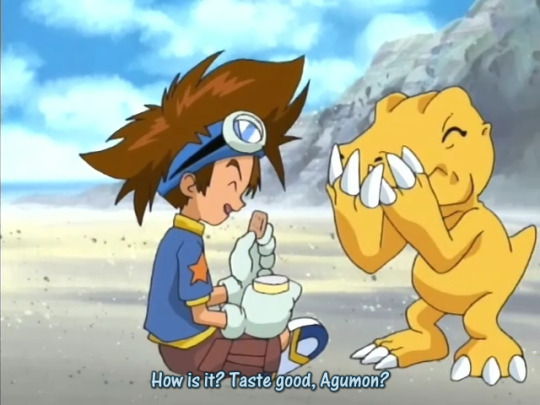
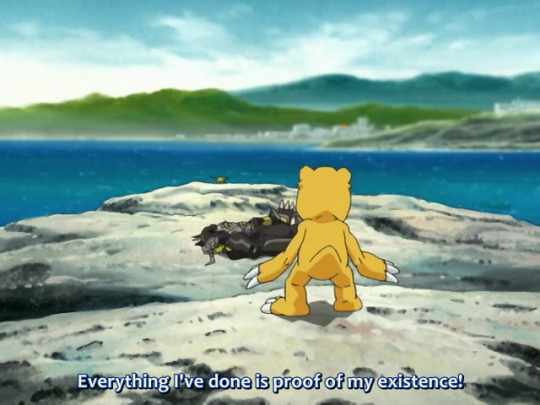
Taichi and Agumon immediately jump to mind as the first among the “like-minded” pairs, especially since the series shows them so often in sync and chilling together. Taichi himself is a straightforward person, so it stands to reason that his straightforward personality would also lend to Agumon coming off as being rather much like him.
However, there is one slight difference between the two, and it’s that Agumon has a somewhat stronger sense of “easygoing chill” than Taichi does, right down to using the more polite boku first-person pronoun in contrast to Taichi’s more assertive ore. He also lacks Taichi’s penchant for mild insensitivity -- in fact, very unlike Taichi, he has an incredible amount of emotional insight (02 spends quite a bit of time in 02 episodes 32 and 46 to showing off Agumon as someone who makes up for all of his lack of intellectual understanding with emotional and borderline poetic insight). And, really, while Taichi is a bit surface-insensitive, and while he seems to be impulsive, he actually is a conscientious person and is trying his best in his own way, and he isn’t the kind of person who cares about societal things like seniority, and he demonstrates multiple times that he’s easygoing and chill, and so you can say that’s a part of Taichi as well. Remembering that a Digimon partner’s presence helps their own human partner grow, Agumon being so openly friendly helps Taichi maintain good relations with others without running afoul of them.
One of Agumon’s most famous traits is that he likes food, which is not actually something that was in the original Adventure or 02 all that much but has been somewhat exaggerated since. That said, back in Adventure, while it was established that all Digimon regularly need food in order to maintain their evolutions, Agumon would usually be the first to complain “I’m hungry,” and whenever they did get food, Agumon would be one of the most prominently enjoying it. Food is, after all, one of the simplest and most universal of pleasures, and there’s a lot of visual framing of Taichi chowing down just as ravenously as Agumon is -- so, honestly, he probably got it from him.
Taichi also speaks a bit about his pain of being separated from Agumon in the space between Adventure and 02, and he directly refers to Agumon as “the other me”. The word “partner” was not actually used very much in the original Adventure or 02, and Taichi is not able to fully elucidate the sentiment of Agumon’s connection to his own self, but he still understands this much and why the loss cuts him so deeply, and by the time we get to Kizuna, it’s presumably why he uses similar language in his thesis proposal to refer to him. (I already covered the circumstances of Agumon’s relationship to Taichi’s existential crisis in Kizuna and how it led to their separation earlier, so I will omit it here for the sake of avoiding redundancy.)
Yamato and Gabumon

This might surprise some people to hear, but I would also pin this as one of the more ostensibly “like-minded” pairs. Gabumon is shy on the surface, but turns out to be quite passionate -- he uses the same assertive ore as Yamato, in contrast to Agumon’s boku, and he demonstrates his capacity for passion an action in that he’s arguably one of the most assertive in the cast. Note his taking initiative against Yamato’s frostbite in Adventure episode 9, or declaring his intent to stay with Yamato even if it means going against the others in Adventure episode 44, or singlehandedly dragging Yamato out of the hole of darkness in Adventure episode 51.
And, of course, Yamato himself is someone who initially seems a little awkward or detached around everyone, but is actually very passionate, so that’s all the same. And because Gabumon himself is so open about communicating with the otherwise closed-in Yamato, Yamato is able to express himself better over the course of Adventure.
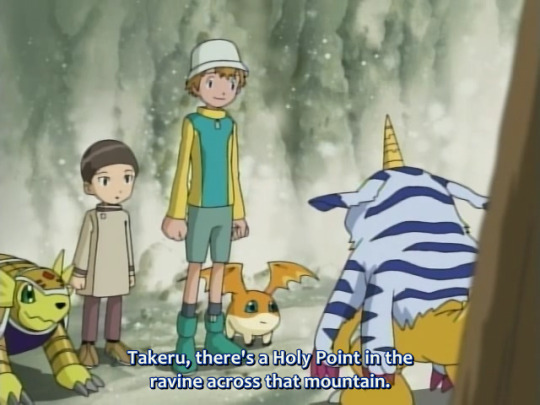
Funny thing about that “shyness”, too -- the idea of Gabumon being particularly shy isn’t present in 02 much at all (we don’t get to see him very much, so it’s hard to say whether it’s completely gone, but it’s at least gone enough for the duration of his appearances). Which is funny, considering: guess who else stopped being shy and became naturally outgoing in 02? Yeah, so, as much as you might hear people (even official!) claim that the Digimon are static while their partners change, that’s not completely true -- the Digimon themselves develop in personality in the same way their human partners do. It’s just more subtle and less drastic, since they’re representing an abstract single part of their personality rather than being an exact match.
Sora and Piyomon

Sora and Piyomon have an interesting relationship in that they’re the only one where their relationship started off on a note of conflict -- mainly in that Sora was very put off by Piyomon at first and even looked down condescendingly on her (well, only for the duration of a single episode). In fact, Sora’s own surface behavior is very different from the kind and caring Sora we know -- Sora dislikes associating with the clingy and affectionate Piyomon for being “mushy”, and even declares that she doesn’t want to “take responsibility” for lugging her around.
Of course, Sora’s character arc later revolves around the fact that she has abysmally bad self-awareness and doesn’t even realize that she has a compulsive sense of responsibility to others. So Sora is affectionate and loving -- she just puts up a front of trying to act a little above that (well, at least, during this part of the series) and doesn’t even see herself as someone capable of being like that (again, purely during this part of the series).
Piyomon is also interesting in that she has one of the most dramatic personality shifts even as early as Child to Adult, where she suddenly switches from the casual atashi to watashi (sometimes even kono watashi, which is super regal), and becomes incredibly dignified and regal even as Birdramon, and you can certainly see why Sora immediately started taking her seriously thereafter. It also begs a lot to think about, considering Sora’s very convoluted character and the many layers of herself that even she isn’t consciously aware of.
The way Piyomon helped Sora shift her own mentality is pretty directly handed to you on a plate in Adventure episode 26 -- because Piyomon played the role of Sora in the metaphor of Sora’s behavior towards Piyomon correlated to Toshiko’s behavior towards Sora, Sora was able to re-adjust her position relative to her family and consider her both someone capable of love, and someone who is loved.
Koushirou and Tentomon
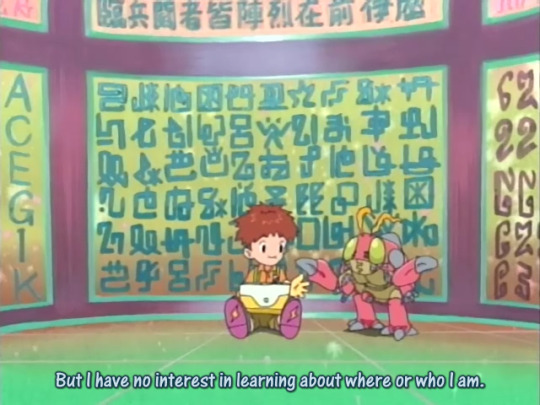
Koushirou and Tentomon are another pair that initially seem like they’re opposing types, with Koushirou being constantly curious and Tentomon being comparatively simple-minded, but the first key to figuring out where the similarity is ends up being a bit deceptive -- Tentomon says in Adventure episode 5 that he’s not particularly interested in himself. And, certainly, Koushirou is interested in Tentomon, but he, too, is not interested in himself -- in fact, he considers himself to be a topic he’d rather avoid instead of looking into everything else.
As far as language goes, while Tentomon does also use the stereotypically easygoing Kansai dialect, he also specifically uses the polite form, mirroring Koushirou’s own perpetual use of polite language. But unlike Koushirou, who uses it to keep distance from others, Tentomon is in fact very sociable, and is even portrayed as a Digimon who’s conscientious of others and “takes care” of them. And because Tentomon is so openly friendly, he manages to coax Koushirou out of his shell and allow him to think about more complicated things related to his own position in the world that he’d been avoiding.
As Koushirou’s character arc proceeds, we learn that he’s polite not only out of distance but also because he really is a very kind person, and moreover that he does eventually want to open up to others. And the payoff for this eventually comes in 02...

...when he ends up becoming one of the most visible members of the older Adventure cast to appear in the series, checking in on the younger kids and developing into someone capable of organizing and managing people. Hmm, seems familiar.
Mimi and Palmon

This one’s an easy one. Mimi is possibly the most straightforward person in the original Adventure cast -- well, that’s the point of her Crest after all -- and so Palmon is almost exactly like her, being a cheerful type who loves being cute. Any contrast between them is only really apparent in the very early episodes of the series, and that’s not even a contrast in theory as much as it’s just something that might intrigue audiences at first when Mimi spent a lot of those episodes complaining, but that’s also mostly because she was heavily under stress, and otherwise Mimi has always been kind, cheerful, and enjoys being cute.
Perhaps the only real difference is perhaps that Palmon, being a plant, is more willing to get involved with dirt and other things that Mimi ostensibly would rather not, but as the series progresses, Mimi manages to gain a higher sense of tolerance and get past her initial sense of materialism (which is something she’d had the capacity for the whole time).
Jou and Gomamon

Of the Adventure pairs, this one is probably the one that seems like the biggest contrast on its face, with the overly high-strung and constantly stressed Jou, and the more playful and relaxed Gomamon.
In the end, Jou is someone who’s defined by his desire to support others, and even admits at the end of the series that he’s better suited for a support role than for fighting, and that there’s nothing wrong with that as long as he continues to channel his desire to help people in a way he’s most comfortable with. So, in the end, he’s not actually an inherently aggressive type. And, meanwhile, Gomamon is the kind who’s constantly looking out for Jou, to the point of knowing (such as in Adventure episode 7) when he’s about to do something phenomenally stupid and minding him so that nothing bad happens to him, and so, this is probably why they’re ultimately able to settle down and end the series eye-to-eye (or perhaps hand-to-hand).
And, again, recall that Digimon partners generally reflect a part that’s vital to their own human partner’s growth; considering that Jou is most certainly one of the more extreme personalities in this cast, you get the feeling that he probably needs someone this chill to keep his massive stress tendencies in check.
Takeru and Patamon

Takeru and Patamon are an interesting case largely due to the two of them being so present for a whole two series. In Adventure, both of them seem to be largely like-minded, being playful, innocent, and childish -- although Patamon is more open about expressing the childishness that Takeru keeps trying to cover up. Patamon being roughly on the same playing field (no pun intended) as Takeru means that Takeru has someone he’s willing to be open with and let himself loose a little (such as in Adventure episode 12), because for the first half of the series, he’s almost entirely in the presence of elders and stifling himself for the sake of being “well-behaved”, and it starts his long journey of being able to understand his position and his actual sense of emotions over the course of Adventure and 02.
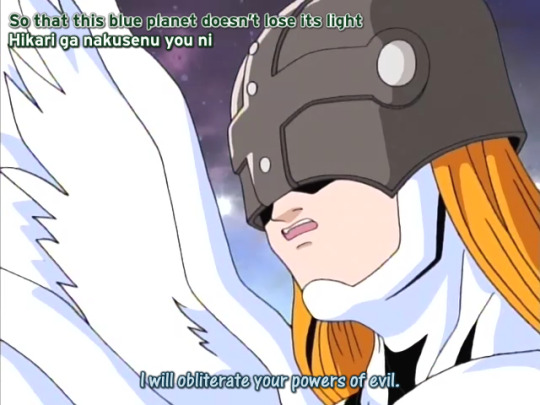
Patamon also has a striking personality change upon evolving, becoming the regal and dignified Angemon, and, interestingly, his appearances have a very “knight templar” vibe where he takes a no-compromise stance against dark forces and states that he’ll condemn all of them to oblivion. This is a stance that’s unnervingly similar to Takeru’s own no-compromise stance against the darkness in 02, and it’s interesting in that Takeru himself had been advocating for pacifism in Adventure episode 12, but this incident traumatized him enough to start taking a position that more resembled Angemon’s.
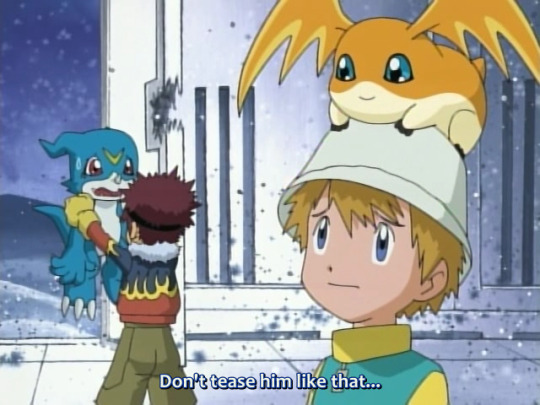
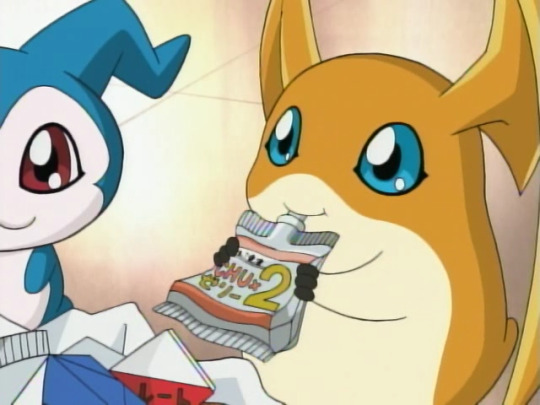
As we go into 02, Takeru’s contrast with Patamon initially seems like an increased mismatch, since Patamon is still ostensibly childish and playful while Takeru is ostensibly more mature. But for one, Takeru’s character arc is about the fact that he’s still pretending he’s more in control of his emotions than he actually is, and in some way you can also glean that there’s a sort of naivete present in his character that he keeps covering up with confident smiles. Patamon, for his part, does actually seem to have adopted a bit of a mentor role to the other Digimon, and we also learn that he’s capable of deliberately trolling people instead of just being generically playful -- much like Takeru himself, who’s a bit evasive and not entirely honest.
We do actually see Patamon reach HolyAngemon in 02 episode 34, but it doesn’t work out well, and while this is partially for plot mechanic reasons, it also says a lot that the “knight templar” stance that both Takeru and HolyAngemon have, with the full depth of no-compromise, isn’t going anywhere, and in the end, something more effective is only possible when Shakkoumon appears in 02 episodes 36-37 -- that is, Takeru is only able to better move on with Iori’s support.
Hikari and Tailmon
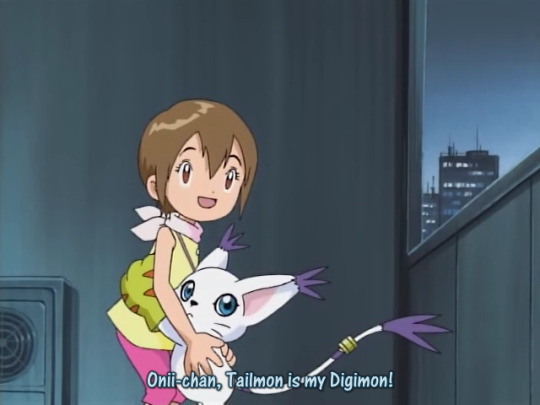
Hikari is the only of the Tokyo Chosen Children to have a Digimon who “defaults” to Adult instead of Child or lower, and it means that Tailmon herself comes with a certain amount of maturity -- on top of having been become a bit hardened due to her experiences being isolated. This is an ostensible contrast to the more pure-hearted and innocent Hikari, but note that Hikari’s own will can be pretty assertive when it comes down to it. On top of that, as much as Tailmon is a bit standoffish, Hikari is also “emotionally isolated” -- she has trouble vocalizing her negative feelings, and it’s difficult for anyone in Adventure or the first half of 02 to truly connect with her internal thoughts. Recalling that the Digimon partner reflects a side of the human partner that’s less easily exposed and allows the human partner to grow in ways they wouldn’t before, Tailmon’s sheer presence gives Hikari a route to action in ways she probably wouldn’t have beforehand.

In 02, Hikari becomes a little more mischievous and playful, and Tailmon also becomes a bit more willing to indulge (she even switches first-person pronouns in sync with Hikari, going from the more polite watashi to the more casual atashi). Both of them are now more able to enjoy themselves more openly. That said, Tailmon still has a certain degree of stuffy personal pride (she snarks at everyone quite easily for fussing over snacks in 02 episode 3), and Hikari herself remains emotionally elusive and repressive at the start of this series.
Tailmon evolves temporarily to Angewomon in 02 episode 13, which is the first time anyone (in this case, Takeru) makes some degree of headway to reaching out to her and allowing her to open up a bit more, but it’s not until 02 episode 31 when Hikari is fully reached out to via Miyako in 02 episode 31, which marks the first appearance of Silphymon.
Daisuke and V-mon

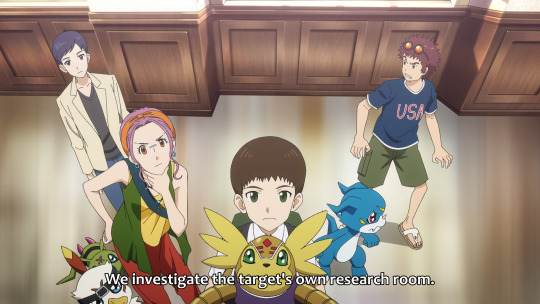
Now here’s a very like-minded pair, even more so than Taichi and Agumon -- and, after all, Daisuke is simple-minded, so painfully simple-minded that he’s practically incapable of hiding anything, and so V-mon is almost exactly like him, down to using the same ore pronoun and being feisty and mischievous (a point is also made that he plays soccer with Daisuke, something that Agumon didn’t necessarily do with Taichi), and, heck, in a rare show of Digimon-Digimon crushes, has a crush on Tailmon in the exact same way Daisuke has on Hikari. (By the time we get to Kizuna and its higher animation budget, a lot of attention is paid to having even their body language mirror each other.)
There is only one real functional difference between the two in disposition, and it’s that V-mon is very straightforward, friendly, and kind, without being prone to getting angry or spiteful at anyone, and in the end, it’s indicative of the fact that Daisuke’s tendency to lash out defensively at everyone is just a front -- at his core, he’s friendly, supportive, and kind. Daisuke’s experiences and banter with V-mon contribute to him getting the sort of validation he needed without having to worry about being on edge or lash out defensively, and because of that, he was able to form a healthier and more supportive relationship with the rest of the group.
Miyako and Hawkmon
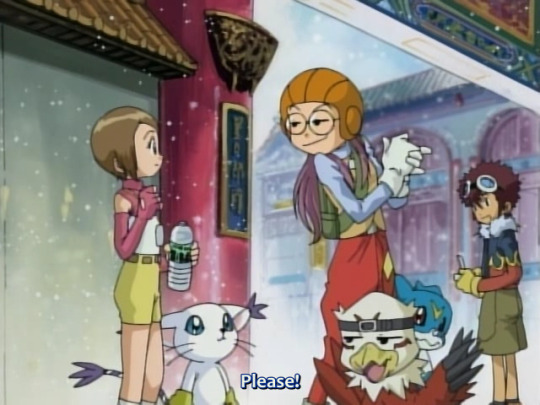
(At the time of this writing, I still haven’t finished writing a comprehensive Miyako meta yet -- I plan to, don’t worry! -- so this is a bit of an abridged preview.)
This one seems to be a contrast right off the bat -- Miyako is bubbly, over-the-top, and rather messy and lacking in restraint, whereas Hawkmon is formal, graceful, and polite. But Hawkmon’s most prominent trait is his absolute loyalty and devotion to Miyako -- he’s very often referred to by both official staff and fans as her “knight” -- and is constantly minding her to protect her and make sure she doesn’t go over her head (most prominently, 02 episode 18). And as far as Miyako’s relationship to others goes -- she’s also devotedly loyal to everyone she loves and is constantly going out of her way to help others, and her character arc in itself is about the fact she wants to do her best to reach out to people and help emotionally support them in the best way she can, and Hawkmon managing to channel that to its utmost extent to Miyako in turn (in a very “who watches the watchman?” sense) allows her to regain her bearings and have better control over herself in the aftermath of 02 episode 18.
On top of that, as the series proceeds, it turns out that Hawkmon also shares Miyako’s penchant for dramatic theatrics and being a bit over his head -- even if he seemingly has himself more together than Miyako does, he’s not completely above it all...
Miyako is also the franchise’s first example of a female character with a masculine Digimon partner, and while Miyako herself openly identifies with and indulges in all things hyper-feminine, she also has zero issue engaging in more masculine-associated things as they suit her -- most prominently her Digital World outfit, and the fact she often displays a rather aggressive go-getter and hot-blooded/in-your-face personality that would not be out of place on a male shounen hero in a more conventional show. (Although, as much as these have generally been on the thread of “less visible aspects”, it’s not like this was that less visible of an aspect of her to begin with...)
Iori and Armadimon

Iori and Armadimon hold the honor of being the only pair in the Tokyo Chosen Children to be voiced by the same voice actress (Urawa Megumi), driving the parallel down even further. And while their surface temperaments seem different, with Iori being rather uptight and strict on himself while Armadimon is laid-back, carefree, and even somewhat assertive, they’re not that different -- Armadimon is basically the curious, impressionable, somewhat childish spirit that Iori would be if he weren’t constantly holding himself back. (There’s a lot to be said about Submarimon going out of his way to take Iori for a ride in 02 episode 16 so that Iori can finally properly enjoy himself for once.)
Iori takes a lot of very stubborn, no-compromise positions over the course of 02, but Armadimon asking just the right kinds of questions allows him to “snap out of it” and be a little more receptive to considering alternatives, or at least taking into account more emotionally-oriented issues he’s dealing with. You can say that Armadimon (especially as Upamon) softening Iori up a bit -- since Iori will never be cold or unforgiving towards his partner, no matter what -- serves as a precursor to Iori starting to question the limitations of his black-and-white view of morality, which allows him to successfully break through to Takeru and fill out the rest of his character arc.
Ken and Wormmon
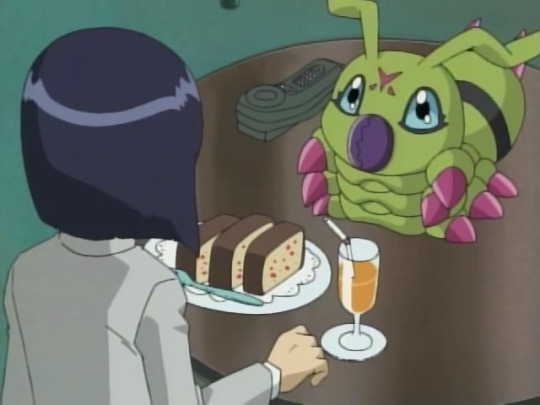
Considering how much of the plot revolved around this one, this one almost goes entirely without saying! During Ken’s stint as the Kaiser, Wormmon represents the heart that Ken’s not entirely willing to leave behind -- and, also, the affection that he’s still craving from his family. The Kaiser going practically out of his way to deny Wormmon yet paradoxically keeping him around is basically his attitude towards his own “weak” and naturally kindhearted self. Notably, recall that the principle of “a Digimon will never deny their partner” applies here -- Wormmon’s “betrayal” of the Kaiser isn’t really any kind of denial, since he was doing it mainly for Ken’s own sake, and, more symbolically, it’s Ken reaching his own limit and coming to realize that this path isn’t what he really wants.
Wormmon is unusually clingy to his own partner over the course of 02, and it’s vital to Ken needing to learn to love himself and also getting important validation that he needs, especially during the critical point in time during 02 episodes 23-30 when he’s still not sure how to approach the rest of the group -- Wormmon gives him someone to talk to honestly and openly, giving him a proper springboard to sort out his complicated feelings about the others and himself. You can say also that as Ken becomes more open and straightforward over the course of the latter half of 02, he, in turn, becomes much more shameless about showing affection and opening his own heart.
Wallace, Gumimon, and Chocomon
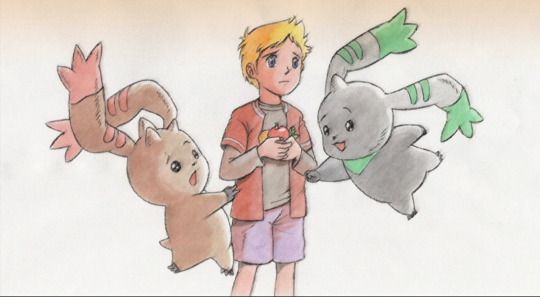
Bonus round!
While it’s hard to fully apply Hurricane Touchdown to this theory (by official admission, it wasn’t properly cross-referenced with the original Adventure/02 series lore, and trying to correlate all of the evolutions in this movie to something metaphorical will give you a headache), Wallace’s two partners still fit very neatly into this overall theory of Digimon partners as a part of the self. Wallace is a character with very sharp duality, trying to be a flirt who asserts himself as a vagrant who’s about to “become an adult”, yet still feels an obligation to keep calling his mom and is engaging in increasingly self-destructive behavior.
Most pertinently, Gumimon and Chocomon represent the two stances Wallace is torn between: wanting to “return to the past” (Chocomon) because he’s still hung up on having lost Chocomon and is convinced that he can make everything just like it was before, and “being able to productively move on” (Gumimon). For most of the early parts of the movie, Wallace is stuck on Chocomon’s mentality of fixating on the past, and Gumimon isn’t even remotely subtle when he draws an explicit parallel between the two (saying that Chocomon didn’t like the heat, followed by offering to give Wallace shade as a hat). But once the conflict escalates and Wallace realizes just how deep in denial Chocomon is, to the point of being destructive to himself and others, Wallace comes to embrace Gumimon’s stance of practicality and moving on. In the end, the ultimate conclusion is reached, and Wallace is forced to fully accept that latter stance when Chocomon dies, but the movie’s ending (and Kizuna) provide an extra option: allowing the past to come back, but in a new form and treading new territory instead of trying to make it “the way it was before”.
210 notes
·
View notes
Text
Chinese folk religion: Festival of the Flowers
Today, March 27, 2021, is the traditional Chinese festival known as “Huachao’jie/花朝节”. This festival falls on the full moon of the Third Month in the Chinese Lunar Calendar. The festival used to be popular but has since fallen out of public knowledge in the last century, with only select rural communities and provinces still celebrating it. It has been experiencing a revival in recent years. Reason being the Goddess celebrated on this day is no longer seen as “significant” or “important” enough in people’s lives. This is the day that Huashen (花神) is celebrated and made offerings to. This is the time when the first spring flowers start to bloom in the wild and in orchards. She is also known by her name Huawang (花王), and Nu’yi (女夷).
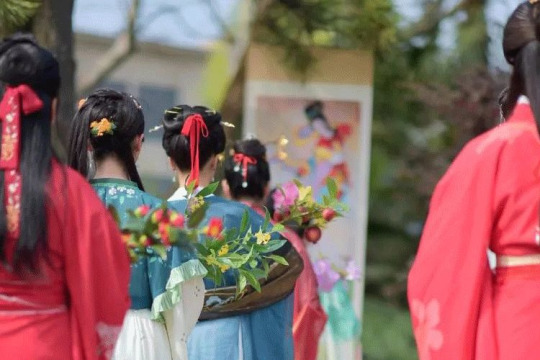
She is belived to be the Goddess who reawakens the plants and trees every spring. It is said she is responsible for “making all trees, grass, plants, and flowers under the heavens sprout, bloom, and grow”. She is attested in Huainanzi (old Chinese text from 193 B.C.), said to reawaken the plant life on Earth every spring with her drumming, dancing, and singing. The interesting thing is that in old texts she is mentioned to not only oversee the growth of plants, but also “the growth of beasts”. Meaning she reawakens the animals and wildlife every spring and makes them grow and reproduce. For this reason it’s still common to this day in certain regions for women to ask her for fertility. Just as she makes orchards bloom and grow, so may their families bloom and grow.
As blooming and flowering of plants are crucial to crops, she is also an important deity for farmers and orchards. Young women would walk trough flower orchards in groups and tie red ribbons onto the branches, asking Huashen to bring them blessings.
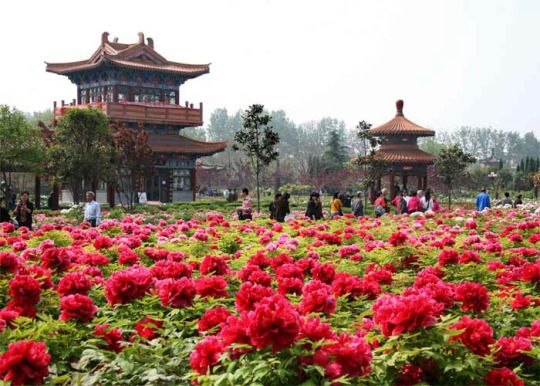
Altars can be set up in orchards or in groves, usually with a painting or small votive image of Huashen and offerings of flower cakes, candles, incense, and sweet liquor would be made to here. Ritual protocol dictates that it is taboo for men to lead the ceremony or to make the offerings. This is an event lead by women or female heads of the household. Sweet liquor are then to left out for her in the groves along with a portion of the cakes.
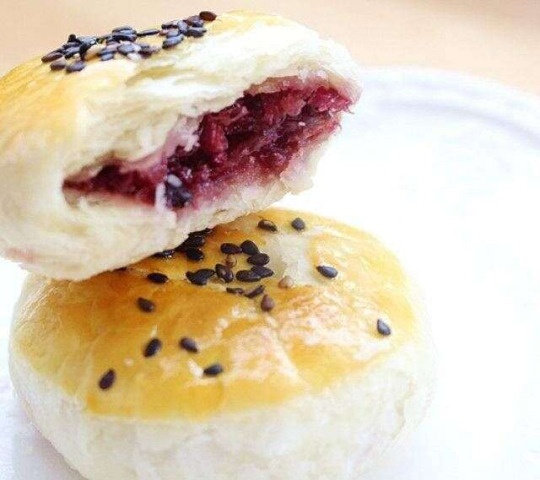
As mentioned, the traditional offering is a pastry called flower cake, or huagao/xianhuabing (花糕 / 鲜花饼). Depending on region, this is either a baked flaky pastry made with a filling made out of crushed fresh flower petals (usually roses), sugar, and lard, or a steamed leavened rice cake with crushed flowers mixed into the rice flour. They’re actually available at major Asian supermarkets, imported from China. If you can get your hands on some, do it and (if weather permits where you’re at) enjoy it under the sunshine by the flowers.
441 notes
·
View notes
Text
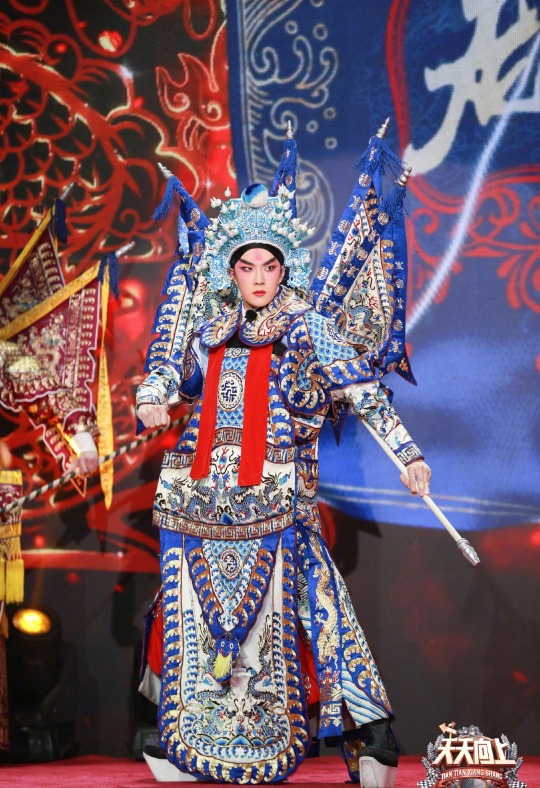
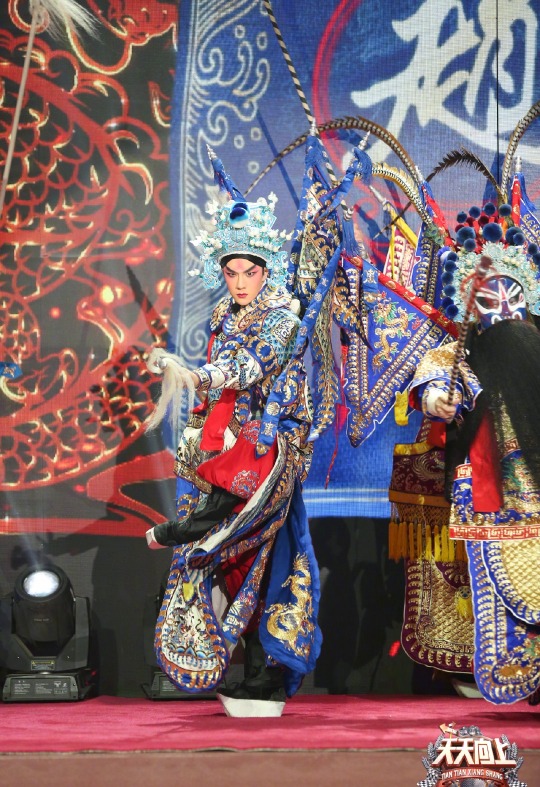


PEKING OPERA · YIBO ! ! !
DDU 2021 01 03
P28
236 notes
·
View notes
Link
11 notes
·
View notes
Text
Where novel attitudes on Nanman came from
From my response to the AskHistorians question Did the portrayal of the Nanman in Luo Guanzhong’s Romance of the Three Kingdoms reflect stereotypes which learned Chinese people held about the Nanman?
You can either read it there or here but thought some might find the attitudes towards the Nanman intresting
Keep reading
16 notes
·
View notes
Text
Mulan Getting an Oscars Nod for Best Costume is a Joke, so Here’s A List of Period Dramas in 2020 that had Better Costumes
Mulan Getting an Oscars Nod for Best Costume is a Joke, so Here’s A List of Period Dramas in 2020 that had Better Costumes
In the past decade, costume designers of Chinese period pieces have tried recreating artifacts, revitalizing traditional textile printing methods, built entire hand-embroidery departments, experimented with a variety of Western fabrics and silhouettes for fantasy and sci-fi costumes, but Disney’s live-action Mulan is here to remind that Hollywood still thinks of them as that dirt-poor country in…

View On WordPress
622 notes
·
View notes
Text
Happy valentines day!

17 notes
·
View notes
Text
Chinese knots (中国结)
What Is a Chinese Knot?
A Chinese knot is a knot that is tied and woven from a single length of cord or rope to be a variety of shapes and of varying complexity. Each shape has its own symbolic meaning, and nowadays you can find them as decoration, gifts for special occasions, and adornments on clothes.
Each kind of knot is named after its shape or the symbolic meaning that it carries. Knot weavers can use a variety of colors, but they usually weave deep red ones as in the picture above. The color red signifies good fortune.

Ancient and Modern Use of Artistic Knots
Several styles and colors of Chinese knots
Even today, Chinese knots are rich in symbolic meaning, and they therefore hold sentimental value when given as gifts or passed down through families.
For example, in ancient times and even now, lovers may give a knot as a token of their love. The ‘true love knot’ and the ‘double happiness knot’ are given or used at weddings to express mutual love and growing old together in fidelity. Knots connoted love and marriage in Chinese culture.
Knot Etymology
This connotation can even be seen in Chinese words. The Chinese word for ‘rope’ is ‘shèng’ that sounds similar to the words for ‘spirit,’ ‘divine,’ and ‘life.’ Knots had a spiritual meaning and were used for worship.
The word for ‘knot’ itself is ‘jié’ and is related to many other terms that reinforce the symbolic meaning of the knots. For example, ‘tuán jié’ which means ‘to unite,’ ‘jié hūn’ means ‘to marry,’ and ‘jié guŏ’ means ‘bear fruit,’ ‘result,’ or ‘outcome.’ So a knot given to a marriage partner or a couple means all these things and having children as well.
Modern Usage of Artistic Knots
Along with being symbolic gifts or messages, knots are still used if they wear traditional Chinese clothing or as good luck charms. They are a means of fastening traditional garments instead of buttons or wooden pegs. Now, silk is most widely used to make these clothing knots.
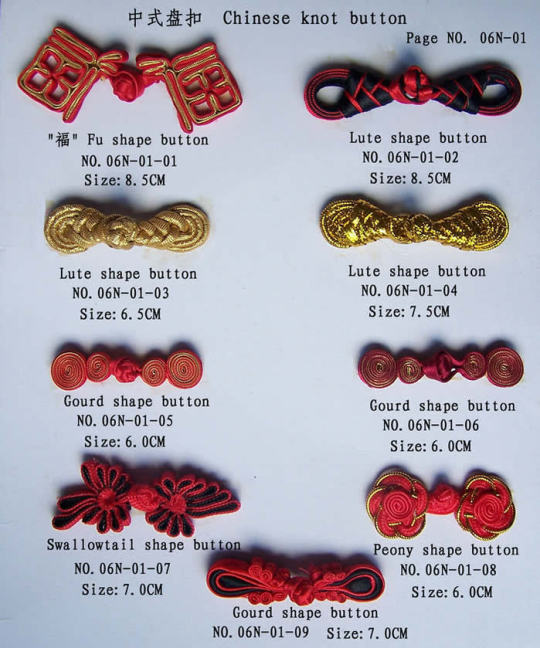
They are used as jewelry such as even rings, earrings, bracelets, and necklaces. They are sold as handicraft novelty items too.
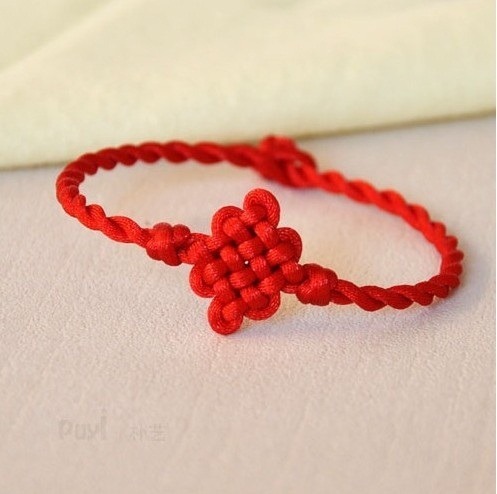

Source: chinahighlights
3K notes
·
View notes
Text
Chinese New Year! 新年快乐!
*please note that the information below isn’t celebrated by everyone in the same way. Some customs are more common in northern China rather than southern China and vice-versa.
How to wish someone a Happy Chinese New Year:
1. 新年快乐!Xīnnián kuàilè! - Happy New Year! (This can be used one the first day of the lunar calendar as well as the Gregorian calendar).
2. 新春快乐!Xīnchūn kuàilè! - Happy Spring Festival!
3. 新年好!Xīnnián hǎo! - Hello! (This is how you greet people during Chinese New Year).
When greeting or wishing someone a Happy Chinese New Year, many Chinese people wish their family and friends things like: “I hope you have a happy and healthy family,” “I hope you get a job promotion,” “I hope you have good fortune and pockets overflowing with gold.” Here are some examples:
4. 恭喜发财!Gōngxǐ fācái! - Wish you a successful and prosperous year! (This saying is known well because of this Chinese New Year song you can watch here).
5. 阖家幸福! Hé jiā xìngfú - Wish you a happy family!
6. 事业有成! Shìyè yǒu chéng - Hope you have a successful career!
You can watch this YouTube video or read this article to learn more about how to wish someone a Happy Chinese New Year!
🧧🧧🧧🧧🧧🧧🧧🧧🧧🧧🧧
What is Chinese New Year?
Chinese New Year, also known as lunar new year or the spring festival, celebrates the first day of the new year on the lunar calendar. In 2021, this holiday falls on Friday, February 12! This holiday is the most important holiday to those who celebrate this - its importance can be comparable to how Americans celebrate Christmas.
People have been celebrating Chinese New Year for about 3,500 - 3,900 years. It’s exact origins are unknown, but this tradition is believed to have started in the Shang Dynasty (1600-1049 BC) when people would make sacrifices to the gods and their ancestors towards the end of a year. However, the tradition was recorded and official during the Han Dynasty (202 BC - 220 AD) when Emperor Wu began using the lunar calendar. He chose to follow this calendar because it would let him know when second new moon after the winter solstice was.
Now, many Southeast Asian countries and people besides the Chinese celebrate Chinese New Year such as: Koreans, Vietnamese, Tibetans, etc. However, it is common to not see Japan celebrate Chinese New Year.
🐮🐮🐮🐮🐮🐮🐮🐮🐮🐮🐮🐮
Why do I keep hearing about the Year of the Ox/Cow?
Just like in western culture, there are zodiacs in eastern culture that the Chinese follow. There are 12 zodiacs, and these zodiacs follow a cycle of 12 years. Each new year represents one of the zodiacs.
In order, they are: Rat/mouse, Ox/cow, Tiger, Rabbit, Dragon, Snake, Horse, Sheep, Monkey, Rooster, Dog, and Pig.
2021 is year of the Ox/Cow - 2020 was year of the Rat/Mouse - 2019 was Year of the Pig… and so on.
Because each zodiac has its own characteristics, they define a year. Chinese zodiac scholars have said in 2021, Year of the Ox, will be a flip-around positive change. They believe this year will be lucky and that it will be a good time to focus on love and relationships. People who are born in years of the Ox are known to have a lot of endurance, be calm and confident, but are also stubborn.
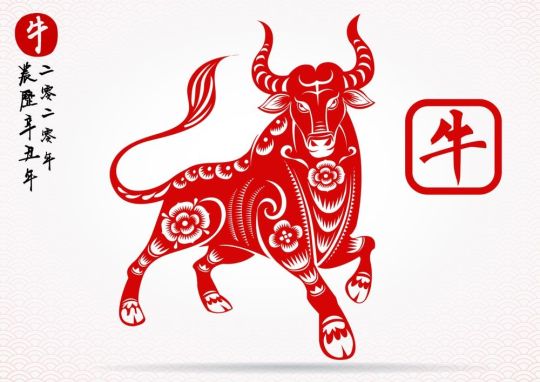
Just like in western culture, these zodiacs are believed to affect personality, fortune, etc, and instead of getting your zodiac by your birth month, you get your zodiac by your birth year. If you are interested in your Chinese zodiac, you can type in your birthday on this calculator and read about it.
🏮🏮🏮🏮🏮🏮🏮🏮🏮🏮🏮🏮🏮
What happens during Chinese New Year and how long do you celebrate it for? Lantern Festival?
On average, Chinese New Year is celebrated for about 15-16 days (from about New Year’s eve to the first full moon). Preparations start seven days before New Years because stores and restaurants close and people travel to be with their families. Most students are also on their big break during this time - they get off from school around the beginning of january and go back after Chinese New Year. It should also be noted that Northern China and Southern China celebrate the new year differently.
During the preparation period, people go shopping for food and decorations. They also clean the house very well. If living in a different city than one’s family, many people will travel back to their hometown to celebrate with family.
During the New Year’s Eve period, the house is decorated with New Year’s decorations, and there is a reunion dinner with family at the host’s house. Out of all the dinners you have during the year, it is incredibly important you don’t miss this dinner, which is why there are so many issues with travelling during this time. At this dinner, you eat many lucky foods such as dumplings and fish. Also during this time, the older generations will give younger generations something called 红包, which translates to “red envelope.” These envelopes are filled with money and are only given on very special occasions such as new years and weddings. Friends give these to each other, but it is not common at all for a younger generation to give one to an older generation person. There is a custom where families stay up late to “watch over the new year,” which is called 守岁. Late at night, people also like to go to temples to hear the first bells of the new year ring because they believe it will drive away bad luck.
On Chinese New Year’s Day, fireworks go off, families cook and eat large meals together, sacrifices are made to ancestors, etc. (Fireworks are especially important because they believe it will make your business more successful.) One popular tradition you might know of is the dancing lion/dragon parades where people wear a dragon costume and parade through the city. Dragons are very representative of Chinese culture and are thought to bring luck to a community. Lions are a symbol of protection.
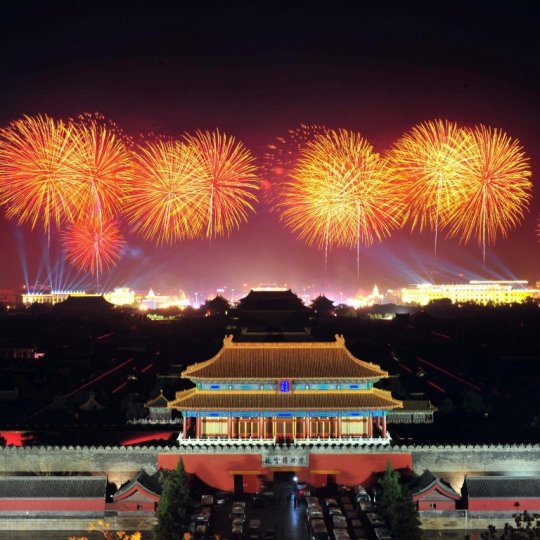
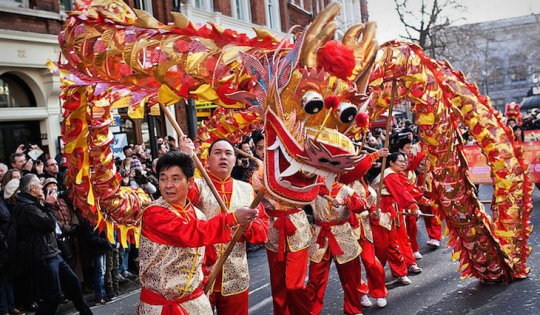
For about a week after the first day, most people go visit family and friends. A lot of times people will visit the other side of their family. For example, someone will spend most of the time with their mother’s side of the family during the new year, then during this week, they will go visit relatives of the father’s side.
After that week, most people go back to work. This is around day 8-10. Businesses, restaurants, and stores reopen, and many people leave their hometown to go back to jobs in the city.
Day 15, the final day of Chinese New Year, is the Lantern Festival. On this day, the first full moon of the new year happens. To celebrate, people will light more fireworks, revisit family, eat sweet dumplings (called tangyuan), and participate in the Lantern Festival. People release lit lanterns into the sky to honor dead ancestors. This is called 元宵节.
You can read more here.
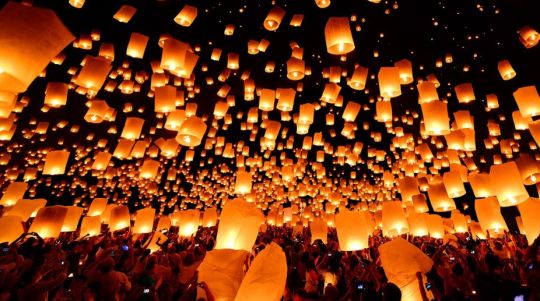
🥟🥟🥟🥟🥟🥟🥟🥟🥟🥟🥟🥟🥟
What foods are eaten during Chinese New Year, and what do they represent?
During Chinese New Year, many special foods are eaten, and these are foods that are considered to be lucky and to bring fortune into the new year.
1. Dumplings - represent wealth. Dumplings take hours to make and involve family help. They’ve been eaten for at least 1,800 years and are especially popular in northern China. It is said that the more dumplings you eat during the new year, the more money you will make.
2. Fish - represents prosperity and success. The word “fish” in Chinese sounds like the word “surplus” in Chinese.
3. Glutinous Rice Cake/Nian gao - represents success in your work (more money, better position).
4. Spring rolls - represent wealth. They get their name because they are most often eaten during the Spring Festival which is CNY. This dish is more popular in eastern and southern China.
5. Oranges, tangerines - represents luck and fortune. This is originally a Cantonese custom, but many people grace their tables with citrus fruits. The word for “tangerine” sounds similar to the word for “good fortune” in Chinese.
6. Longevity noodles - represents longevity. These noodles are longer than usual to represent a person’s long and happy life. This is more commonly eaten in northern China. *It should be noted that these are mostly eaten on birthdays but can be eaten during the NY as well.
7. Sweet rice balls/tang yuan - togetherness in family. This food is eaten during the Lantern Festival, the last day of Chinese New Year. The shape and pronunciation is associated with closeness of the family.
8. Snacks - represent a sweet and pleasant life. Any sweet snack like dried fruit, candy, tanghulu is eaten during this time.
When it comes to food during Chinese New Year, there are superstitions about how foods should be prepared and what makes them lucky. You can read more about them here as well as here.
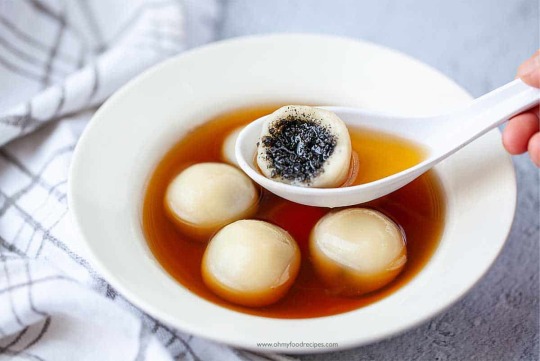
🎇🎇🎇🎇🎇🎇🎇🎇🎇🎇🎇🎇🎇
What kinds of decorations are put up in houses during the new year? What do the colors represent?
1. Spring/door couplets - These couplets originated in the Shu era. As seen in the picture below, you post these on doors in couples - in Chinese culture, even numbers are seen as good luck. On many of these couplets are written wishes or poems for the new year. Each couplet should have the same rhythm and the same number of words.
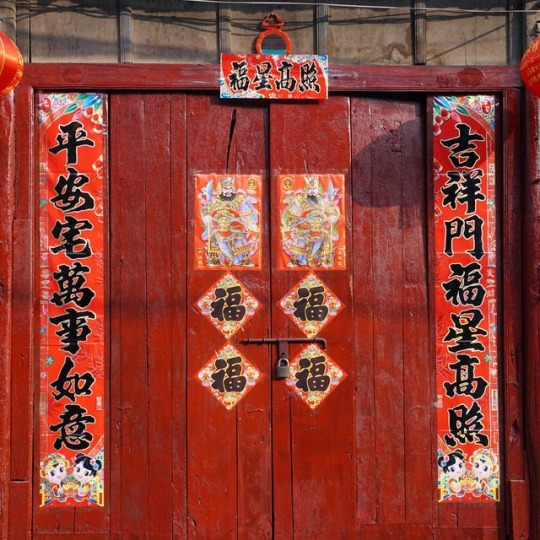
2. Paper cutting - Translated as “window flower,” these intricate, red paper cutting pieces are placed on windows and often represent the zodiac of the new year or other symbolic animals such as fish, dragons, and phoenixes.
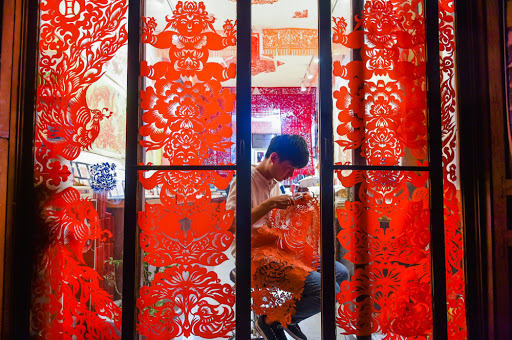
3. Upside down characters/Fortune - Many Chinese people during the new year hang up positive characters such as Fu, which means happiness and good fortune. It is written in calligraphy on a red piece of paper and then put upside down on doors and windows. It is hung upside down because the people want the good fortune to fall down onto them.
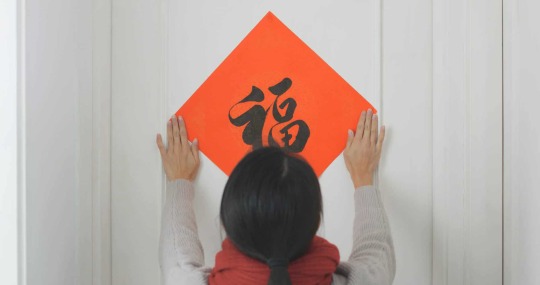
4. Red lanterns - These lanterns push away bad luck and are seen during both the Spring and Autumn Festival. They can be hung on trees, outside houses, etc. There are also many styles - they can come in many shapes and have symbols written on them.
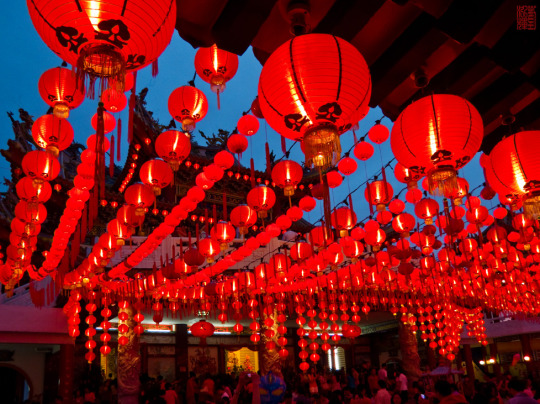
5. Kumquat trees - As said before, citruses represent good luck and fortune. People place kumquats and citrus fruits on their tables or decorate their homes with small kumquat trees.
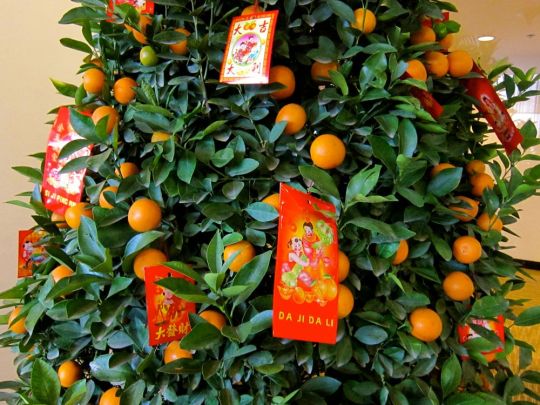
You can read more about decorations here as well as here.
Common colors seen during Chinese New Year are red and gold, but green can also be found.
The color red is not only dominate during Chinese New Year, but it is also very representative of Chinese culture as well. Red signifies fire, good fortune, and happiness. It is representative of good luck, keeps the holiday very joyous, and scares away bad spirits.
Gold or yellow is considered to be a very beautiful color. Gold symbolizes wealth, riches, and prosperity.
Green represents money, harmony, and growth.
Though these are the most common colors, it should be noted that a color combination of green and red is considered to be tacky in Chinese culture.
🍊🍊🍊🍊🍊🍊🍊🍊🍊🍊🍊🍊🍊🍊
What do people wear during Chinese New Year?
On the first day, it is traditional to wear new clothes and new accessories as it symbolizes new beginnings. However, there are people who like to wear sentimental accessories to respect and remember their ancestors.
Some people like to wear traditional Qipao/Cheongsam, Tang Suits, and Hanfu, but many people stick to western clothes like skirts, dresses, and pants. There is also a tradition of wearing lucky, red underwear for New Years.
Tang suits are the most popular to wear during the New Year, Qipao is also popular, but it is often too cold to wear during the winter months. Many people are starting to wear Hanfu again to celebrate the new year, but it isn’t widely accepted yet to wear during the new year.
During the new year, people wear a lot of red and gold. It is important to NOT wear mostly white and/or black. These symbolize death, and white is worn at funerals. Anything that is bright, bold, and upbeat should be fine to wear, but you should go for something that is red.
*If you want to wear something that is traditional Chinese for New Years, please make sure you know about cultural appropriation and know how to wear these properly.
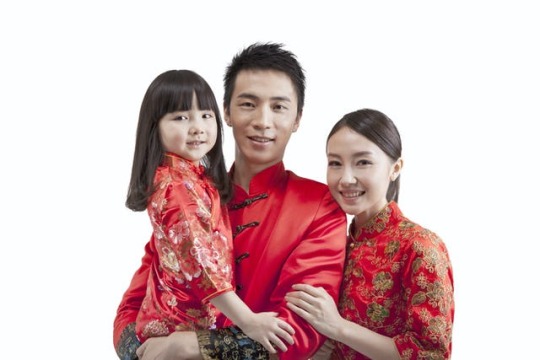
🐉🐉🐉🐉🐉🐉🐉🐉🐉🐉🐉🐉🐉
As there is so much information about Chinese New Year, I cannot possibly tell you all about it in one post. It is truly something that you must experience in your lifetime. It is very beautiful, fun, and there are so many things to do and celebrate. I ask you that you please research this more and look at all the beautiful pictures of food, lanterns, fireworks, etc.
Please stay safe and 新年快乐!
4K notes
·
View notes